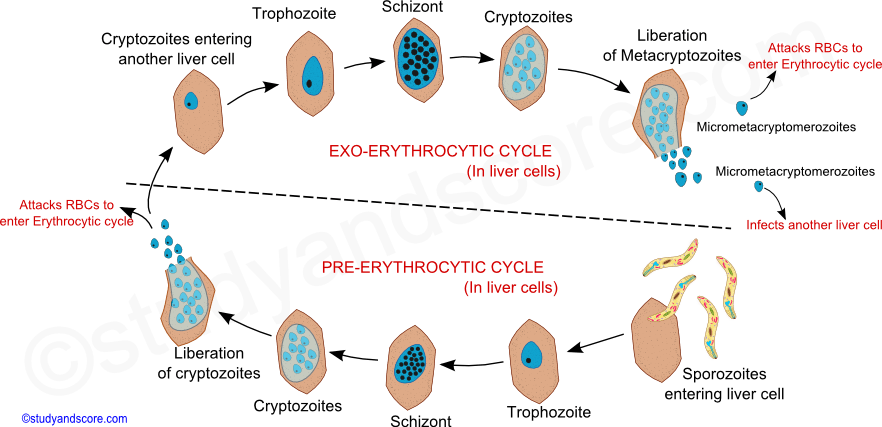Plasmodium vivax, plasmodium ovale, plasmodium falciparum, and plasmodium malariae are the organisms causing malaria in human beings. Malaria is the most common disease of man. In olden days it was believed that malaria is caused due to the bad air or the harmful vapors produced in the marshy lands. The word malaria is an Italian word meaning mala=bad and aria=air.
Common names: Malarial worm
Distribution: Malarial parasite is wide spread in tropical and temperate countries.
Habit and Habitat: Malarial parasites are either intracellular or intercellular parasites of invertebrates and vertebrates. They reside in the red blood corpuscles. Thee parasites cause the dreadful diseases like malaria, cattle fevers, coccidiosis in chickens, epidemic deaths in cultivated honeybees and silkworms etc.
History of Malaria: For the first time, in 1860, Laveran, a French doctor, observed the Plasmodium in the blood of a malarial patient. Then Golgi, an Italian scientist in 1885 observed Plasmodium in the red blood cells of a malarial patient.
On 20th August 1897, Ronald Ross discovered the oocytes of Plasmodium in the crop-wall of the female Anopheles mosquito. For his work on malaria Ross was awarded Nobel Prize in 1902. Also every year 20th August is celebrated as the Malaria day in recognition of his Work. Ross carried out a major part of his work on malaria in India. Grassi, an Italian professor described the complete life cycle of Plasmodium vivax in female Anopheles mosquito.

The infective stage of the malarial parasite, Plasmodium to man is called Sporozoite. The sporozoites are spindle shaped with swollen middle part and slightly pointed ends. It measures about 15 µ in length and 1µ in width. Externally the body of plasmodium is covered by a three layered pellicle which is elastic in nature. It contains longitudinally arranged hollow microtubules. These tubules are contractile in nature and help the parasite in its wriggling movement.
At the anterior end a cup like depression called the apical sucker is present. In to this apical sucker, opens a pair of narrow secretory organelles called rhoptries. These secretory organelles secrete cytolytic enzymes which help in penetration of the parasite in to the liver cells. Numerous convoluted tubules are scattered throughout the body of sporozoite.
The following table shows characteristic features of four different species of plasmodium:
| Character | P. vivax | P. malariae | P. ovale | P. falciparum |
|---|---|---|---|---|
| Distribution | Worldwide | Worldwide | Worldwide | Worldwide |
| Pre-erythrocutic cycle duration | 8 days | 7-12 days | 9 days | 5-6 days |
| No. of Merozoites formed per schizont | 10,000 | 2,000 | 15,000 | 40,000 |
| Erythrocytic cycle duration | 48 hours | 72 hours | 48 hours | 36-48 hours |
| No. of merozoites formed per schizont | 12-24 | 6-10 | 6-12 | 18-24 |
| Incubation period | 14 days | 18-24 days | 14 days | 12 days |
| Fate of host RBC | Enlarged with red schuffner's dots | Not enlarged, Ziemann's dots | Slightly enlarged with schuffner's dots | Not enlarged, Maurer's dots |
| Pigment | Yellowish brown | Dark brown to black | Dark brown | Dark brown to black |
| Type | Benign | Quartan | Mild tertian | Malignant tertian |
| Effects of malaria | Low death rate | Severe | Severe | High death rate |
The life cycle of plasmodium includes two phases, namely asexual and sexual which are completed in two different hosts. The sexual phase of the life cycle is completed in the female Anopheles mosquito and the asexual phase is completed in human beings.
Female Anopheles mosquito is considered as the definitive host or invertebrate host whereas humans are considered as the intermediate hosts or vertebrate hosts. Mosquito is also called as the vector as it transmits the parasite from one person to another.
Monkey is the reservoir host. In the life cycle of the plasmodium the asexual life cycle alternates with the sexual life cycle. This phenomenon is called as alternation of generations.
Life cycle of plasmodium in Man: Human Phase
Plasmodium vivax reproduces by asexual multiple fission called as schizogony in the liver cells (Hepatocytes) and the red blood cells (Erythrocytes) of humans.
The two stages in the human phase are exoerythrocytic stage and erythrocytic stage.
In the liver cells two generations are produced-the earlier generation is called as the preerythrocytic generation and all the later generations are called as exoerythrocytic generations.
For more detailed notes on life cycle of plasmodium click below...

Life cycle in Mosquito: Mosquito Phase
The life cycle of the plasmodium in mosquito is called Ross cycle, in recognition of the work done by Sir Ronald Ross. When a female Anopheles mosquito bites an infected human, the gametocyte stages present in the blood of the infected human enters the mosquito. Only the gametocytes present in the blood survive the digestive action in the crop of mosquito and all the other stages are digested. The pH of the digestive fluid and the body temperature of the mosquito are favorable factors for further development of the gametocytes.
The life cycle of the plasmodium in mosquito includes the following events:
For more detailed notes on life cycle of plasmodium click below...


Hope you have liked this post.
Please share it with your friends through below links.
All the very best from Team Studyandscore
“Study well, Score more…”
- Share with your friends! -
Login to post your comment here...
- or with social Account -